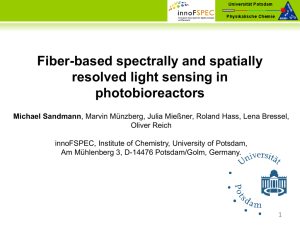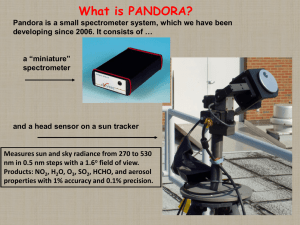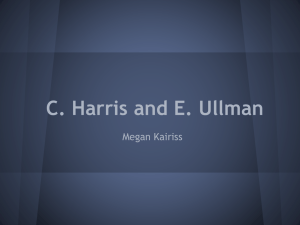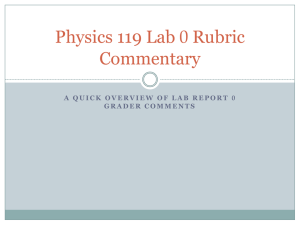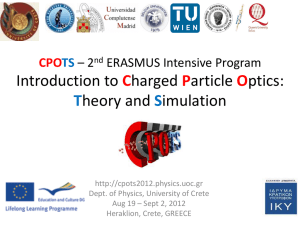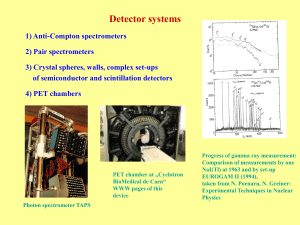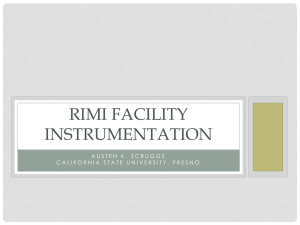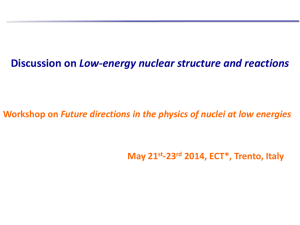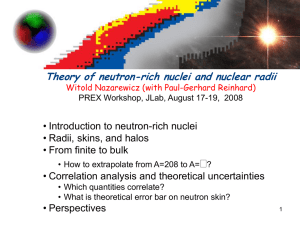GANIL PROPOSAL FOR EXPERIMENT
advertisement
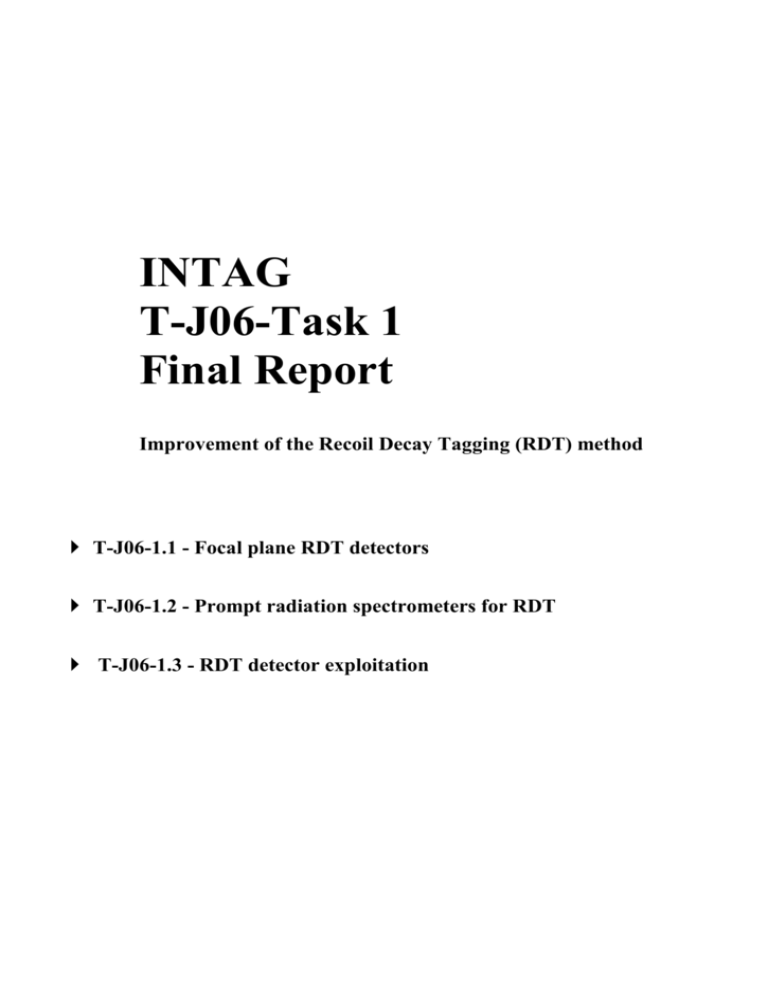
INTAG T-J06-Task 1 Final Report Improvement of the Recoil Decay Tagging (RDT) method T-J06-1.1 - Focal plane RDT detectors T-J06-1.2 - Prompt radiation spectrometers for RDT T-J06-1.3 - RDT detector exploitation JRA06: Instrumentation for Tagging (INTAG) Task T-J06-1: Improvement of RDT method T-J06-1.1 - Focal plane RDT detectors A proof of principle- experiment of the beta- tagging method was successfully carried out in Jyväskylä. The beta-tagging method has been applied to a study of 78Y. In 2007, a scintillator detector replacing the planar Ge detector in beta-decay-tagging measurements has been carefully tested in various modes of operation with sources at JYFL. It was successfully used in a beta-tagging study of 71Kr, the mirror-nucleus of 71Br (Extended Report below) For gamma-isomer tagging experiments a gas detector to replace the Si DSSD implantation detector has been built by Manchester University, ready for experiments in 2007. One Clover and two VEGA detectors have been added to the GREAT spectrometer. The GREAT spectrometer with a planar Ge and a large Clover Ge detector was used to identify the decay of K- isomers in the heavy elements. The ASICs for the Musett project have been delivered this year. A new mother board "cofee" for the ASICs has been delivered and is being tested. A new VME card has been designed and tested at Saclay for the chip readout (See Task 4.2). Recoil Beta Tagging method for studies of near proton drip-line N = Z nuclei in the A~70 region Nuclei in the mass 70 region around the N=Z line exhibit interesting nuclear phenomena that includes, shape co-existence and neutron-proton pairing effects. Their structure is also known to influence the paths taken by the astrophysical rapid proton capture processes. In addition, information on these nuclei is often used to test the standard model of particle physics. Such an intense interest has been the motivation behind the development of sensitive tools to study these nuclei that typically are produced with very low cross sections. In last few decades, developments of the Recoil Decay Tagging (RDT) technique have enabled studies to be carried out on nuclei that possess proton or α decays with short half lives. Here, we present a brief summary of a recently established novel technique that is appropriate for the nuclei having Fermi super-allowed β decays with high end point energies (around 8 to12 MeV) and short life times (around 50 to 100 ms). We refer to the method as Recoil Beta Tagging (RBT). This has been developed at University of Jyvaskyla, using the RITU recoil separator and the JUROGAM γ ray and GREAT spectrometers in order to carry out studies on proton rich nuclei. As shown in the schematic picture in Fig. 1, only the JUROGAM events associated with the recoils transported to the focal plane are considered. A combination of the Double Sided Silicon Strip Detector (DSSSD) and the Planar Ge Detector (PGD) in the GREAT spectrometer serves as a telescope for the β particles. The telescope was used to select the high energy β particles, i.e., the high energy β cut that further filters out the unwanted γ rays in the JUROGAM array. a) b b) c)c Fig.1 Schematic drawing of the Recoil Beta Tagging technique. a) Recoils are selected using the energy loss verses time of flight technique. b) In the top the telescope is shown where a part of particle energy is deposited in the DSSSD and rest is implanted into the PGD. In the bottom typical Fermi-curie distribution can be seen for different channels. As can be seen only the Fermi superallowed decaying nucleus has events at higher energies. C) A typical high energy cut, used in the RBT method. A time correlation of ~ 100 ms between the β particle and the γ ray, i.e. the short time correlation, which is appropriate for the β decay half-life of the nucleus under study, discriminates all the long lived activity. In this method, we consider only the JUROGAM events that are validated by high energy β cut and short time correlation which gives a clean γ spectrum essentially corresponding to the Fermi super-allowed β decaying nucleus. Figure 2 illustrates the cleanliness that one can obtain for the 74Rb test case that was produced with only few μb cross section while the total cross section for all other channels suppressed by the RBT method was ~ 100 mb. Figure 3 shows the plastic scintillator for high-energy β detection that was used to replace the planar Germanium detector in the GREAT spectrometer for some of the experiments. This modification increased the β detection efficiency of at least 20%. When applied to an unknown case of 78Y, the method resulted in interesting information on the Isobaric Analogue States. Currently, the analysis on 70,71Kr nuclei is underway where we applied the RBT technique to proton rich nuclei beyond the N=Z line. Further work to improve on the RITU transport of the recoils and the β detection is being done. Fig.2 Illustration of the Recoil Beta Tagging technique applied to 74Rb which was produced using 40Ca (36Ar, pn) fusion reaction. The spectra associated with a) recoils, b) recoils + short time correlations of 100 ms and c) recoils + short time correlations of 100 ms + high energy cut. The cleanliness with which the 74Rb lines appear in the RBT spectrum can clearly be seen. . a) b) Fig.3 The beta telescopes a) with the Planar Ge detector and b) with the Plastic Scintillator. T-J06-1.2 - Prompt radiation spectrometers for RDT SAGE: SAGE – Spectrometer Array for simultaneous Gamma-ray and Electron detection. An ultimate goal in in-beam spectroscopy is simultaneous detection of gamma-rays and electrons with highly segmented arrays. Such a combination spectrometer would enable simultaneous collection of gamma-gamma, gamma-electron and electron-electron coincidence information and is therefore of crucial importance especially for the spectroscopy of very heavy nuclei (Report below). LISA: LISA is a new spectrometer designed to measure energies of light charged particles (p, alpha) at the target position of RITU, possibly tagged with the focal plane GREAT spectrometer. (Report below). Digital electronics: Both SAGE and LISA spectrometers need to be equipped with digital electronics. First in-beam tests by using a digitisation card (Strasbourg TNT) have been carried out. Inbeam testing of TNT2 digital instrumentation has been completed at JYFL. It has been shown that by using the TNT cards Ge- detector rates up to at least 30 kHz can be tolerated without deterioration of energy resolution. The TNT2 digital instrumentation has now been used in several experiments at JYFL. Spectrometer Array for Gamma-rays and Electrons - SAGE The interplay between single-particle motion, collectivity and pairing in atomic nuclei results in a rich tapestry of coexisting nuclear shapes and exotic excitations. For decades, in-beam -ray and electron spectrometers have been important tools in nuclear structure research to study these interesting phenomena. However, -ray or electron spectrometers alone can provide only partial information of nuclear de-excitation processes. Earlier experimental set-ups for simultaneous observation of rays and conversion electrons have been optimized to observe either rays or conversion electrons. The simultaneous detection of both rays and conversion electrons is crucial in studies of nuclei far from stability, particularly in superheavy nuclei at low transition energies and high multipolarities, where internal conversion competes strongly with -ray emission (Fig. 1a). The primary physics goal of the SAGE spectrometer will be to investigate the properties of the nuclear mean field at the limits of nuclear stability e.g. the extremes of nuclear mass and isospin. Experiments on superheavy nuclei will be performed aiming to establish the location of single-particle levels responsible for the properties of the next spherical proton-shell closure above Z=82. Theoretical predictions for the location of this doubly magic spherical nucleus vary from Z=114 to Z=126 and N=172 to N=184. This region of interest lies beyond the current reach of direct spectroscopic studies. One could probe it through the study of deformed nuclei around the region of 254No. Predictions indicate that the single particle orbitals near the Fermi surface of these nuclei are the same as those that determine the shell closures in spherical superheavy nuclei. Recent experiments on 254No have shed light on deformation, stability against fission and rotational structure. The spectra shown on Fig. 1b) were obtained from similar experiments on 250Fm. Figure 1: a) Internal Conversion Coefficients of electron and -ray spectra of 250Fm. 254 No for M1 and E2 transitions. b) Recoil-gated The SAGE spectrometer will consist of the JUROGAM II Ge-detector array and a segmented Si-detector. It will be deployed on the RITU gas-filled recoil separator at the University of Jyväskylä and will be coupled with the GREAT focal plane spectrometer as illustrated in Fig. 2. The triggerless Total-Data Readout data acquisition system will be used and the Recoil-Decay Tagging technique will be employed for the data analysis. Figure 2. The SAGE spectrometer coupled with the RITU gas-filled recoil separator and the GREAT focal-plane spectrometer. While rays will be detected promptly at the target position, conversion electrons will be transported upstream the beam from the target position by means of solenoid magnet. A collinear geometry between the solenoid coil axis and the beam was chosen to minimize Doppler broadening of conversion electron lines in energy spectrum. To reduce the flux of delta electrons, a high-voltage (HV) barrier will be used. A carbon foil unit with intermediate pumping will be used to separate the target volume from HV region. The current design is partially shown in Fig. 3. Figure 3. Schematic cross section of the SAGE spectrometer showing the solenoid coils and the target and detector positions. Also the carbon foil unit and the HV barrier are shown. The cones at the target position represent the opening angles of the Ge-detectors, which have been removed for illustration purposes. High-gain charge-sensitive preamplifiers are chosen for the Si-detector due to their compact size and low noise specifications. The preamplifiers and their FETs will be directly mounted on the same PCB as the detector and cooled to -20C. Digital electronics will be used for data acquisition allowing higher count rates than conventional analogue electronics. Lyrtech 8-channel VHS-ADC cards will be used with the Si-detector and similar digital cards for the Ge-detectors. The SAGE spectrometer will exploit the latest detector technology, use the novel data acquisition technique with digital front-end electronics and benefit from experience gained in recent -ray and electron spectroscopy campaigns carried out at JYFL. Mechanical design is close to completion and manufacturing of mechanical bits has started in the University of Liverpool’s workshop. The first shipment will be sent to JYFL in December 2008, including e.g. coil supports. Remaining parts, e.g. detector chamber, will be sent in the second shipment in the second quarter of 2009. Stand for electron spectrometer will be built at JYFL in the last quarter of 2008. Solenoid coils are nearly completed at Danfysik and will be delivered to JYFL in the end of November 2008. Prototype Si-detector has been delivered to Liverpool and will be tested when the first stage amplification (on PCB) design has been completed, possibly by the end of 2008. Digital electronics for 128 channels exists and remaining channels have been funded. Testing of moving window deconvolution code is currently being done in Virtex2 version (SMARTPET card) in Daresbury, JYFL, OLL (Liverpool). Energy resolutions of 3 keV for 1332 keV -rays have been obtained using the GASP type Ge-detector in JYFL and 4 keV for 320 keV conversion electrons using a PIN diode at OLL. TDRi interface card which sends out metronome signals is delivered from RAL to Daresbury. Discussions are going on of using an offset/gain cards to give several/better range in energy spectrum. One option is to design and construct these cards in Liverpool. Compton-suppression sending data into TDR stream and merging is still to be implemented. When all that is done, code needs to be ported to Virtex4 (SAGE ADC cards). It is anticipated that the commissioning of the SAGE spectrometer will take place in the first half of 2009. Light Ion Spectrometer Array – LISA How heavy nuclei beyond the proton drip line behave presents a great challenge to the understanding of nuclear structure, not least because it is no longer possible to ignore the effects of unbound (continuum) states. The proton drip line is defined by nuclei with such a large excess of protons compared with stable isobars that no more protons can be bound to them and they can decay towards stability by proton emission. Proton emission is crucial for defining the limits of observable nuclei for most odd-Z elements because of the sensitivity of the lifetime to the decay energy and the orbital angular momentum of the emitted proton. Once the proton drip line has been crossed, half-lives for proton emission drop rapidly with the removal of successive neutrons, falling below the limit of ~1 ms for current experimental techniques using recoil separators. The consequences of what happens to our classic understanding of nuclei at and beyond the proton drip line will have important ramifications for determining the limit of nuclear existence for proton-rich nuclei. By exploring nuclei at this distant shore of the nuclear landscape, the deviations from the behaviour expected from predictions of nuclear models designed for and fitted to the properties of more stable nuclei should be at their greatest and therefore revealed most clearly. Figure 1. LISA spectrometer installed at the JUROGAM array at the RITU separator Therefore, a new spectrometer will be designed to probe nuclear structure beyond the proton drip line, where half-lives of proton decays will be too short for decay studies using recoil separators. LISA is a spectrometer designed to measure the energies of light charged particles (p,α) at the target position of gas-filled separator RITU, as illustrated in Fig. 1. It will be used in conjunction with the GREAT and JUROGAM II spectrometers. The detector configuration for LISA comprises an annular double-sided silicon strip detector, with 64 radial strips and 32 annular strips on a single wafer, and a barrel comprising 8 position sensitive strip detectors, each having 4 strips along the beam axis. A second, outer layer of annular and barrel detectors will allow particle identification through the ΔE-E technique. To prevent the detectors incurring severe radiation damages, absorber foils will be mounted in front of the Si surface to stop the scattered beam. LISA will be operated in the low pressure He gas environment of RITU, with differential pumping station upstream of the target. The mechanical design of LISA includes positions for up to four targets. The targets can be rotated in order to allow the maximal beam current to be used. LISA will be mounted on a moveable stand allowing the rapid installation of the spectrometer. Several experimental scenarios are envisaged for LISA: 1. as a spectrometer to measure the energies of very fast proton decays (t 1/2 < 10 ns) from low-lying (e.g., ground) states that are too short-lived to survive the ~0.5 µs flight time through RITU. 2. as a spectrometer to measure the energies of very fast proton decays from high-spin states at high excitation energies (≥ 1 MeV). The proton decays would be competing with γ-ray emission and could populate excited states in the daughter nucleus. JUROGAM would therefore be used to pin the initial and final states so that the Qp-values are determined with high precision. 3. in-flight lifetime measurements for very fast proton decays. For these type of studies, special baffles will be mounted in front of the Si detectors allowing measurements of proton intensity as a function of distance. 4. as a channel selection device for nuclei where conventional tagging is not possible. 5. as a veto for charged particle evaporation channels to select weak xn channels. The mechanical design of LISA and its associated target handling system and chamber has proved to be a very complicated task. Nevertheless, the design is essentially complete and the manufacture is well underway, both in Liverpool and Jyväskylä workshops. The Si detectors to be used for LISA are existing designs that are known to work. The detectors have been ordered from Micron Semiconductor Ltd. and are due for delivery in January 2009. A thorough check of the mechanical assembly and to test the Si detectors will be performed in Liverpool and Daresbury, prior to shipping everything to Jyväskylä. The estimated timescale for this is completion by March 2009. A subsequent commissioning experiment will take place soon after that in order to get all elements of LISA operating correctly in situ. First physics exploitation proposals are welcomed to the JYFL PAC in March 2009 and the first experimental campaign with LISA is therefore due mid 2009. T-J06-1.3 - RDT detector exploitation The GREAT spectrometer with a segmented planar and a large clover Ge detector has been installed at the RITU focal plane and employed in a large number of tagging experiments. Some of the most significant results: R.D.Herzberg, P.T.Greenlees, P.A.Butler, G.D.Jones, M.Venhart, I.G.Darby, S.Eeckhaudt, K.Eskola, T.Grahn, C.Gray-Jones, F.P.Hessberger, P.Jones, R.Julin, S.Juutinen, S.Ketelhut, W.Korten, M.Leino, A.P.Leppanen, S.Moon, M.Nyman, R.D. Page, J.Pakarinen, A.Pritchard, P.Rahkila, J.Saren, C.Scholey, A.Steer, Y.Sun, C h.Theisen, J.Uusitalo Nuclear isomers in superheavy elements as stepping stones towards the island of stability Nature(London) 442, 896 (2006) D.T.Joss, I.G.Darby, R.D.Page, J.Uusitalo, S.Eeckhaudt, T.Grahn, P.T.Greenlees, P.M.Jones, R.Julin, S.Juutinen, S.Ketelhut, M.Leino, A.-P.Leppanen, M.Nyman, J.Pakarinen, P.Rahkila, J.Saren, C.Scholey, A.Steer, A.J.Cannon, P.D.Stevenson, J.S.Al-Khalili, S.Erturk, M.Venhart, B.Gall, B.Hadinia, J.Simpson Probing the limit of nuclear existence: Proton emission from 159Re Phys.Lett. B 641, 34 (2006) P.T.Greenlees, R.-D.Herzberg, S.Ketelhut, P.A.Butler, P.Chowdhury, T.Grahn, C.Gray-Jones, G.D.Jones, P.Jones, R.Julin, S.Juutinen, T.-L.Khoo, M.Leino, S.Moon, M.Nyman, J.Pakarinen, P.Rahkila, D.Rostron, J. Saren, C.Scholey, J.Sorri, S.K.Tandel, J.Uusitalo, and M.Venhart High-K structure in 250Fm and the deformed shell gaps at N=152 and Z=100 Phys. Rev. C 78, 021303(R) (2008) The Köln plunger was combined with the JUROGAM+RITU+GREAT system for RDT lifetime measurements. For the first time, the RDDS lifetime measurements were carried out by employing the RDT technique: T. Grahn, A. Dewald, O. Möller, R. Julin, C. W. Beausang, S. Christen, I. G. Darby, S. Eeckhaudt, P. T. Greenlees, A. Görgen, K. Helariutta, J. Jolie, P. Jones, S. Juutinen, H. Kettunen, T. Kröll, R. Krücken, Y. Le Coz, M. Leino, A.-P. Leppänen, P. Maierbeck, D. A. Meyer, B. Melon, P. Nieminen, M. Nyman, R. D. Page, J. Pakarinen, P. Petkov, P. Rahkila, B. Saha, M. Sandzelius, J. Sarén, C. Scholey, and J. Uusitalo Collectivity and Configuration Mixing in 186,188Pb and 194Po Phys.Rev. Lett. 97, 062501 (2006) A new type of collectivity phenomenon has been found in a RDT experiment at RITU: M.Sandzelius, B.Hadinia, B.Cederwall, K.Andgren, E.Ganioglu, I.G.Darby, M.R.Dimmock, S.Eeckhaudt, T.Grahn, P.T.Greenlees, E.Ideguchi, P.M.Jones, D.T.Joss, R.Julin, S.Juutinen, A.Khaplanov, M.Leino, L.Nelson, M.Niikura, M.Nyman, R.D.Page, J.Pakarinen, E.S.Paul, M.Petri, P.Rahkila, J.Sarén, C.Scholey, J.Sorri, J.Uusitalo, R.Wadsworth, and R.Wyss Identification of Excited States in the Tz=1 Nucleus 110Xe: Evidence for Enhanced Collectivity near the N=Z=50 Double Shell Closure Phys.Rev.Lett. 99, 022501 (2007) First in-beam spectroscopy study of an odd-mass transfermium element was carried out: A.Chatillon, Ch.Theisen, E.Bouchez, P.A.Butler, E.Clément, O.Dorvaux, S.Eeckhaudt, B.J.P.Gall, A. Görgen, T.Grahn, P.T.Greenlees, R.-D.Herzberg, F.Heßberger, A. Hürstel, G.D.Jones, P.Jones, R.Julin, S.Juutinen, H.Kettunen, F.Khalfallah, W.Korten, Y.Le Coz, M.Leino, A.-P. Leppänen, P.Nieminen, J.Pakarinen, J.Perkowski, P.Rahkila, M.Rousseau, C.Scholey, J.Uusitalo, J.N.Wilson, P. Bonche and P.H.Heenen Observation of a rotational band in the odd-Z transfermium nucleus 251Md Phys. Rev. Lett. 98, 132503 (2007)
